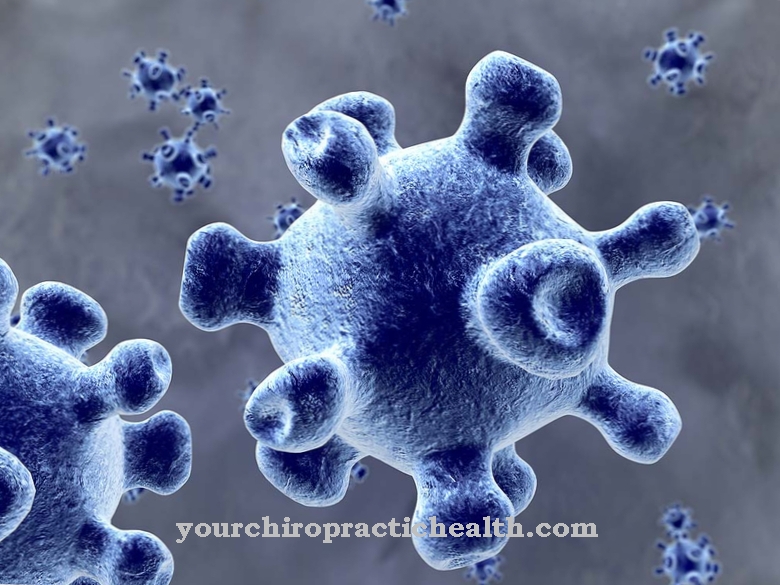The Pityriasis versicolor (bran fungus) is a harmless fungal skin disease that results in a non-contagious, but in rare cases itchy, rash. This skin fungus is treated with the help of locally applied drugs such as ointments or creams. However, the risk of relapse is very high, since the pathogen causing the bran fungus is part of the skin's natural environment.
What is pityriasis versicolor?
.jpg)
© gritsalak - stock.adobe.com
At Pityriasis versicolor it is a harmless infection of the top layer of skin with fungi, the so-called Malassezia furfur. The bran fungus is very common, is not contagious and should be classified as harmless.
Even if pityriasis versicolor has no real disease value, it results in a changed complexion that is perceived as disturbing by most patients. The fungus causes a brownish or pigmentless skin rash, which usually manifests itself as round spots that can reach about three centimeters in size. In pityriasis versicolor, these spots often merge and are usually located in the chest or back area, since this is where most of the sebum and sweat glands of the human skin are located.
If the bran fungus spreads very strongly, the actually harmless rash can itch or become uncomfortable. Some people have increased flaking on the skin in the area of pityriasis versicolor, which can be increased by scratching.
causes
Everyone carries the fungus that is responsible for the development of the Pityriasis versicolor is responsible, on the skin, although most people find it particularly dense on the scalp. Some people develop the rash that is typical of bran fungus. The development of pityriasis versicolor is presumably promoted by profuse sweating in the summer months and by an overactive thyroid.
Other diseases, such as diabetes mellitus, as well as the use of certain medications, such as the birth control pill, can also promote the outbreak of the rash. In general, people who develop pityriasis versicolor often have a weakened immune system.
Symptoms, ailments & signs
The main symptom of bran fungus are spots of different sizes on the skin. These can have a diameter of a few millimeters up to a few centimeters. These spots differ from person to person and depend very much on the complexion of the skin.
On tanned skin areas and on dark skin types, the spots usually appear lighter than the surrounding area. There is a loss of pigment in the epidermis. With lighter skin types, there are more likely to be reddish or brownish spots and thus an increase in pigments. However, the dead skin fungus can also leave light spots after treatment.
The spots usually only appear isolated and can also occur in herds. The spots can also merge into one another and become large patterns on the skin. The bran fungus does not colonize the entire body, but prefers the back, upper abdomen, upper arms and shoulders. The neck and face are rarely affected. The scalp is not affected. All infected areas can be completely colonized by the fungus. The spots are itchy in the least of cases and can sometimes be raised. If they are scratched, they sometimes shed.
Diagnosis & course
The diagnosis of the Pityriasis versicolor is carried out by a dermatologist who examines the affected skin regions with a special black light lamp. In addition, a strip of adhesive film is used to take a skin sample from the patient, which is later examined under the microscope for the fungi responsible for the bran fungus.
This will ensure the diagnosis of bran fungus. The harmless skin disease usually runs smoothly with appropriate treatment and regresses well. However, it occurs again after a certain time in many patients, since the pathogen causing pityriasis versicolor is part of the natural human skin flora.
Complications
As a rule, pityriasis versicolor is a harmless disease. There are no particular complications and the disease can be limited relatively well. The risk of infection is also relatively low with pityriasis versicolor, so that the personal environment is usually not affected by this disease. Those affected suffer from various spots on the skin.
In most cases, these are brown or red and relatively large. Many sufferers suffer from reduced self-esteem or from inferiority complexes because they are ashamed of the symptoms. A rash on the skin can also occur and significantly reduce the quality of life of those affected. In some cases, patients with this disease also experience itching.
Especially in children, teasing or bullying can occur, so that they develop psychological complaints or depression. Pityriasis versicolor is treated with the help of medication. There are no complications. However, this disease has a relatively high risk of relapse, so that those affected get the disease again in many cases.
When should you go to the doctor?
Psoriasis in the area of the upper arms, chest and face indicate bran fungus. A doctor's visit is indicated if the symptoms clearly indicate a serious illness, impair your well-being, or persist for more than a week. Persons suffering from chronic skin diseases should consult the responsible dermatologist if they suspect pityriasis versicolor.
The doctor can determine the condition with the help of a visual diagnosis and prescribe a suitable remedy. No further visits to the doctor are necessary during therapy, provided there are no unforeseen complications or complaints. The cause of the bran fungus can sometimes be determined dermatologically, but the trigger can often no longer be clearly traced.
In addition to the dermatologist, you can also go to your family doctor or internist with the disease. A therapist should be called in if permanent skin changes such as scars or pigment spots occur that have a negative effect on mental well-being. Talk therapy in a support group can also help to accept the suffering and the external blemishes that come with it.
Treatment & Therapy
Treating a Pityriasis versicolor is done through locally applied antifungal agents. Depending on the severity of the rash, the dermatologist can prescribe a cream, lotion or ointment, all of which work reliably against the bran fungus.
Special washing lotions and sprays also help excellently. However, the patient affected by pityriasis versicolor must use the prescribed medication regularly and massage it in carefully. It is advisable to extend the treatment of the skin to the surrounding areas of the skin and to continue the treatment for about two weeks after the visible rash has subsided to prevent relapse.
If a patient is severely affected by pityriasis versicolor or the locally applied antifungal agents do not work, there is the possibility of taking tablets with an antifungal agent, which are also effective against pityriasis versicolor. There is no risk of infection with bran fungus.
Outlook & forecast
Pityriasis versicolor can be cured well in most cases. However, a doctor should be contacted as soon as the first symptoms and signs of the disease appear, so that the disease does not spread further and there are other complications and complaints. Self-healing of pityriasis versicolor cannot occur, so that the person affected with this disease is usually always dependent on a medical examination and treatment.
If the disease is not treated at all, the symptoms usually spread over the entire body and significantly limit the quality of life of the person affected. It can also lead to psychological upset or depression if the fungus also appears on the face.
With the help of creams or ointments, the pityriasis versicolor can be well restricted and also completely cured. However, some people get sick again after treatment and are therefore dependent on regular use of the medication. However, life expectancy is not limited or otherwise reduced by this disease. As a rule, pityriasis versicolor cannot be prevented either.
prevention
An effective prevention of Pityriasis versicolor consists of taking good care of the skin and keeping it dry. Especially in the warm summer months, you should pay attention to loose, breathable clothing made of natural materials, as heavy sweating promotes the development of pityriasis versicolor. In patients who have already had pityriasis versicolor, preventive medical treatment of the skin is recommended, especially during the summer months, to prevent the rash from breaking out again.
Aftercare
In most cases of pityriasis versicolor, those affected have only a few or only limited follow-up measures available. First and foremost, the person affected must contact a doctor very early to avoid further complications or further complaints. As a rule, self-healing cannot occur, so that those affected are definitely dependent on a visit to a doctor.
In many cases, the symptoms of pityriasis versicolor can be alleviated by using creams or ointments. Those affected should always adhere to the doctor's instructions and also ensure the correct dosage and regular use of the drugs. If there are changes on the skin, a doctor must be consulted in any case, so that it does not come to a tumor on the skin.
In the case of children, parents in particular should monitor the child's skin and ensure that the medication is used correctly. Pityriasis versicolor usually does not reduce the life expectancy of the person affected. A complete healing is not always possible, so that no general course can be given.
You can do that yourself
Pityriasis versicolor can only be cured with antimycotics, but can be contained with home remedies. The self-therapy of the bran fungus is not to be seen as a substitute for a therapy with a fungicidal drug. In this respect, the methods described are particularly suitable for preventing the fungus from multiplying while waiting for treatment.
As an experiment, those affected can rub the affected areas of skin with five percent vinegar. Any form of vinegar is suitable, but the concentration should not be exceeded as this can cause skin irritation. If necessary, the vinegar is diluted. The body can be rubbed with a sponge or a washcloth soaked in vinegar. After an exposure time of ten to fifteen minutes, the vinegar is washed off. This procedure can be done twice a day and can kill the skin fungus in many places. However, the spore reservoirs on the head cannot be removed in this way.
It is important that those affected keep their skin dry in order to destroy its preferred milieu for the fungus. Scratching should be avoided as much as possible, as this only leads to flaking and cracks in the skin.
Correct handling of areas of skin that have become discolored as a result of the fungal infection is also important. The use of make-up and similar products does not make sense because exposed skin regenerates itself far better. However, it can take months for the pigmentation to return to normal.

.jpg)























.jpg)


